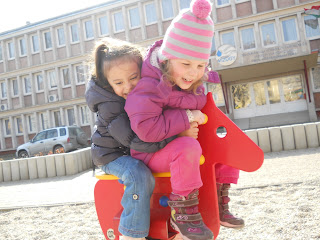Prague's Astronomical Clock, known as the Orloj, was our first post-hotel stop. Every hour on the hour between 9:00 and 21:00, a small show is performed. It is difficult to see in the dimming sunlight, but there is a skeleton ringing a bell on the right hand side and the apostles passing by the two windows above the clock. Keith also got video of the hordes of people who gathered to watch the event.
The mechanical clock and astronomical dial date back to 1410.
The astronomical dial is a form of mechanical astrolabe
, a device used in medieval astronomy.
The astronomical dial has a background that represents the standing Earth and sky, and surrounding it operate four main moving components: the zodiacal ring, an outer rotating ring, an icon representing the Sun, and an icon representing the Moon.
For more information on this part of the clock, click
HERE
Around 1490 the calendar dial was added to the facade and decorated with gothic sculptures.
 |
| Astronomical face above the calendar face of the clock |
 |
| Calendar Face of the Clock |
|
The very outside of the clock goes through the Christian name days. At the "12" there is an arrow pointing to the saint whose name day is celebrated that day. The second circle in with the large 12 circles indicated what people should be doing in the fields at the indicated time (when under the "12"). The 3rd circle of circles indicate the zodiac signs.
In the 17th century moving statues were added, and figures of the Apostles were added after major repair in 1865-1866. (these can be seen in the video clip)
The Orloj suffered heavy damage on May 7 & 8, 1945, during the Prague Uprising , when Germans directed open fire to the south-west side of the Old Town Square in an effort to silence the provocative broadcasting initiated by the National Committee on May 5. The hall and nearby buildings burned along with the wooden sculptures on the Orloj and the calendar dial face
. The machinery was repaired, the wooden Apostles restored, and the Orloj started working again in 1948, but only after significant effort.
According to local legend the city will suffer if the clock is neglected and its good operation is placed in jeopardy.
Prague celebrated the clock's 600th anniversary on October 9, 2010 with a wicked awesome light show. Click
HERE to Czech it out
































